On the cover The eye of a cuttlefish. The chromatophores, the sense organs that allow the animal to quickly change color and camouflage itself, are in frantic activity to try to distract the photographer, which, in this case, is detected as a predator.
FROM 0 TO - 32 FEET (first session)
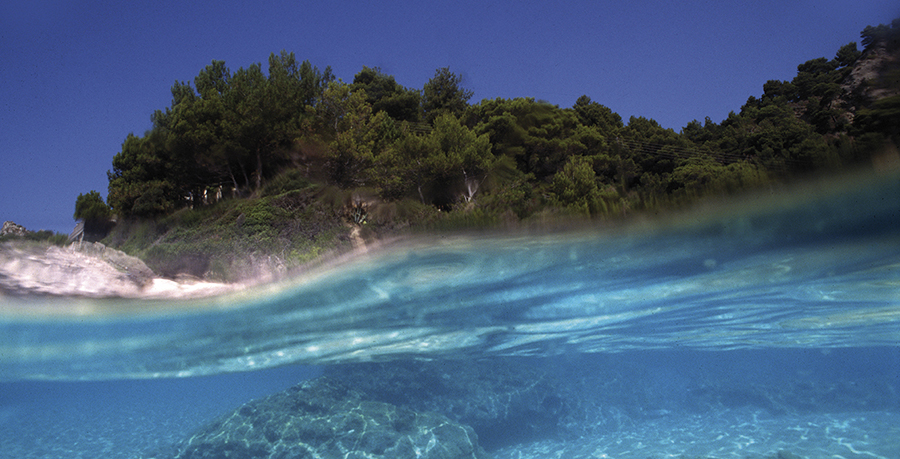 A typical half-water image. In the background there are no classic palms of tropical atolls, but not less attractive shapes and colors of Mediterranean scrubland, that seems to be touching surface of the sea.
A typical half-water image. In the background there are no classic palms of tropical atolls, but not less attractive shapes and colors of Mediterranean scrubland, that seems to be touching surface of the sea.
(Corfu - Greece)
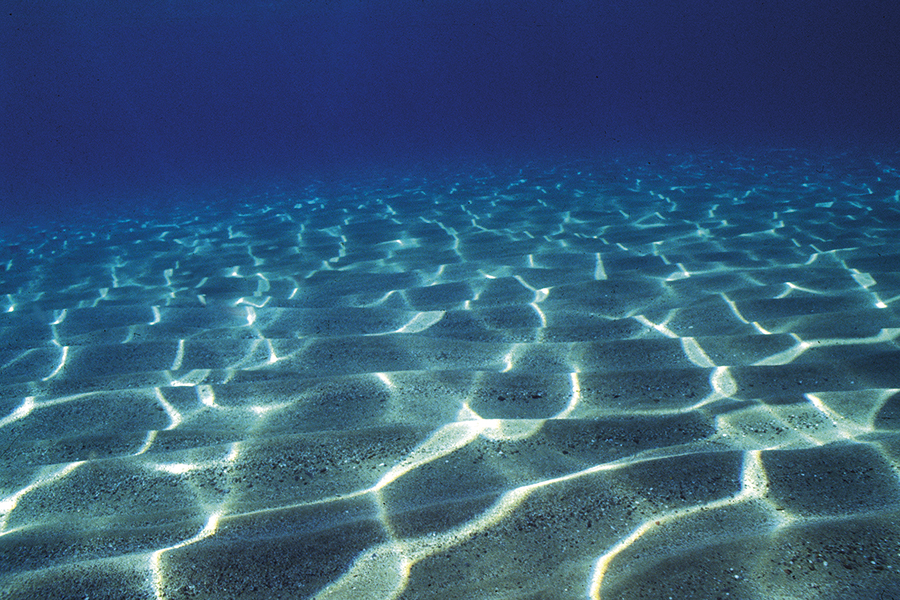
A “classic” shot, openly inspired by an image by the National Geographic Society’s official underwater photographer David Doubilet who is an unrivaled master for more than one
generation of fans. At the beginning of his book in Italian issue called “Hidden Colors”, he published a photograph entitled “submarine desert”. It had been taken in the Red Sea. This shot was taken on the shoreline of Ascea marina, crowded seaside resort of the Cilento coast, in the province of Salerno town. Outside, a few meters away it was a shouting and a kicking of children and parents. When this scene of infinity appeared in the viewfinder of the camera I could not do without thinking about that shot and the author’s caption. Doubilet, in turn, cited legendary commander Cousteau who on one French beach, and in a very similar noisy scenario turned to the sea and saw the world disappearing with a last bow.
I especially love final part: “I was in a jungle never seen by those floating above its opaque roof “.
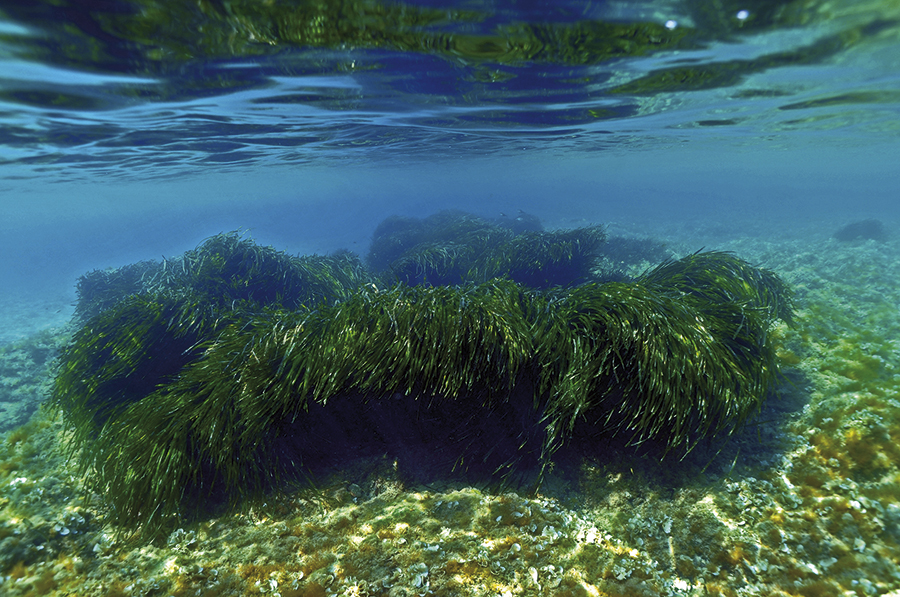
The Posidonia oceanica (Posidonia oceanica) is the true “barrier” of the Mediterranean Sea, although not a coralline, but a “botanic” one.
The Posidonia, wrongly held as an alga by many people, really is a plant in all respects, with roots, flowers and fruits. It might seem like one great expanse of green in appearance, often waving to the rhythm of the currents.
The dry leaves, pushed by the waves and the backwash, often form real artificial beaches. Swimmers turn up their noses to those, often unaware that the carpet is an infallible biological
indicator of a sea in very healthy condition. While we will be going back toward the light we’ll learn that the utility of posidonia grass goes on even out of water.
(Porto Palo - Syracuse)
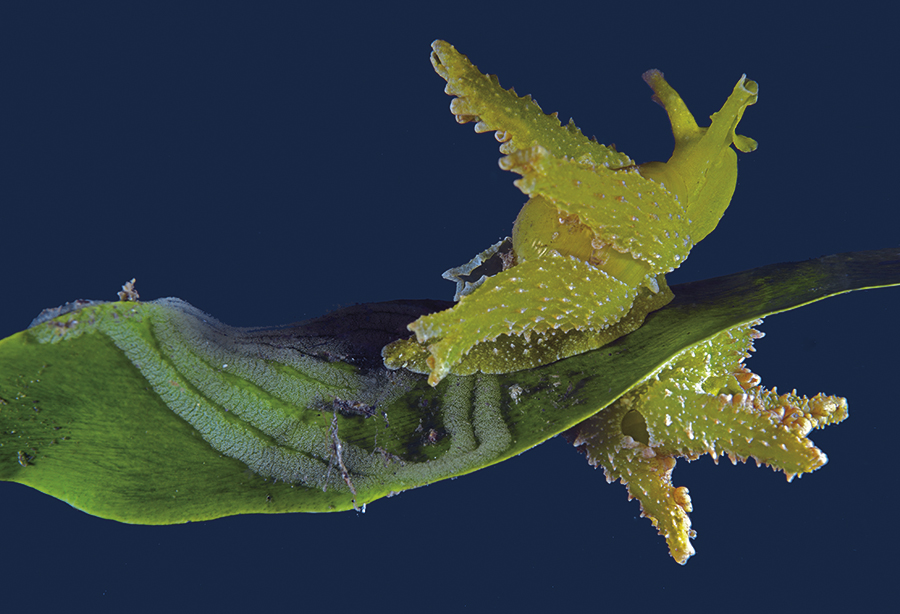 Two lobiger opistobranch (Lobiger serradifalci), sacoglossi mollusks.
Two lobiger opistobranch (Lobiger serradifalci), sacoglossi mollusks.
Sacoglossi means “without jaws”, and unlike the nudibranchs, we will meet very soon, at this stage of evolution still have a residue shell. They are mimetic, they feed and live on the green Caulerpa algae, and proliferates where they lay their typical spiral eggs.
Special feature of the species is to preserve parts of the algae, in order to have a food reserve that lasts a long time. Practically speaking they are a marine camel.
(Dead sea lagoon Bacoli - Naples)
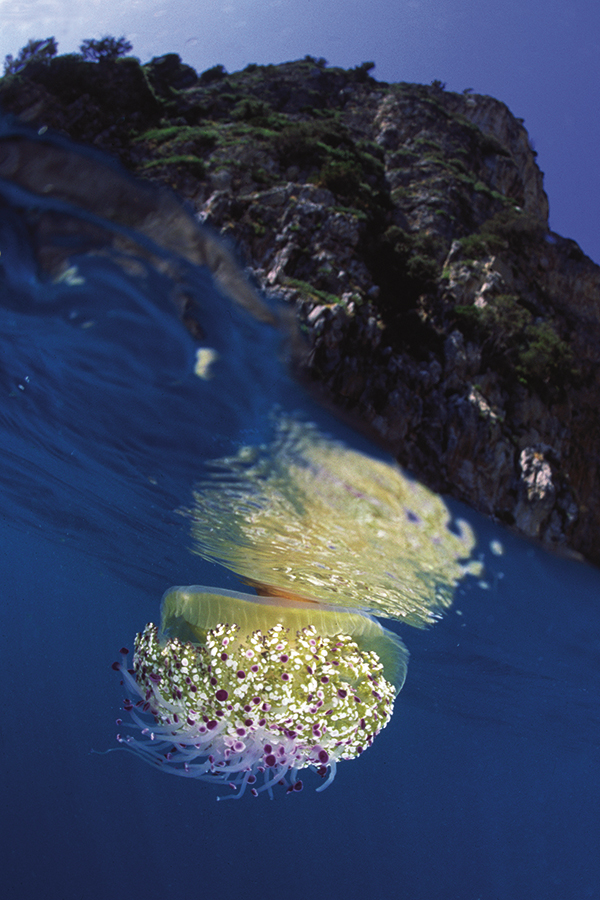
A Mediterranean Cassiopeia jellyfish (Cotylorhiza tuberculata).
According to mythology, meeting the Medusa’s gaze a guy became immediately petrified ... we do not know if because of monstrosity, or beauty of the gorgon. You could playfully comment that if you are swimmers, the first option is plausible, because the fear of coming into contact with the stinging cells leaves.
It is thought that really jellyfish owe their name to the fact that their tentacles, frequently stinging tentacles resemble hair of the mythical gorgon. Cassiopeia, however, was considered the most beautiful and vain among the nymphs, and this is a recognition of the great elegance of these animals.
The genus is present in all seas of the world. It looks fascinating biology of the golden jellyfishes living in Eil Malk lake in Palau, Micronesia. Because of the absence of enemies, they lost their stinging power, already not particularly strong in the Mediterranean species,
demonstrating how defensive strategies are the result of millennial evolution related to environmental situations. In the shot, our subject looks like in a mirror, just like the nymph, while a typical cliff overlooks.
At the end of the dive we will discover another incredible peculiar aspect about a particular jellyfish.
(Capo Palinuro - Salerno)
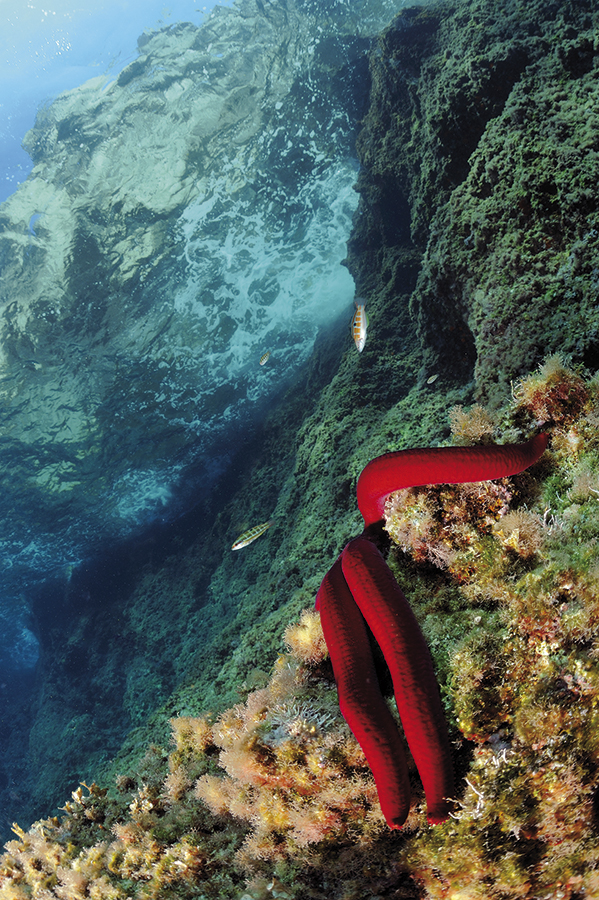
The waves crashing against the rock on the surface, while arms of a typical red sea star (Ophiadiaster ophidianus) seem to approach threatening towards the photographer. This is a typical submarine landscape of the first meters, where light shapes the whole life of the so called infralittoral zone.
Sea stars belong to the class of echinoderms, that means with the “skin made of thorns”, because of obvious defensive reasons. They live both in the rocks and on the sand, as well as in the middle of the algae, feeding essentially on organic debris. They play the role of sea sweepers, and an important role in the delicate ecosystem, linked to the food chain. When they can, they do not disdain crustaceans, hedgehogs, mollusks and sponges, they devour without mercy, extracting the stomach on the prey to suck it up.
Particular biological feature of the stars, in turn victims of some large gastropod mollusk they feed on it, it is that of being able to abandon an arm to its enemy in order to save ... the skin. In fact, the arts regenerate. The aggressors are content with the little, and the star resigns to live moaning for some time. How to say, better lame than dead.
In tropical waters, where the various species show off a great chromatic variety, a species in particular is very feared, the so-called “crown of thorns”, as it feeds on the corals. In the past years there have been real invasions is the being, because of the concurrent decrease of the tritons, which feed on these echinoderms. They have made fear for the survival of the coral reef, to the point that they organized real “crusades” against the crowns of thorns.
(Li Galli Islands - Salerno)
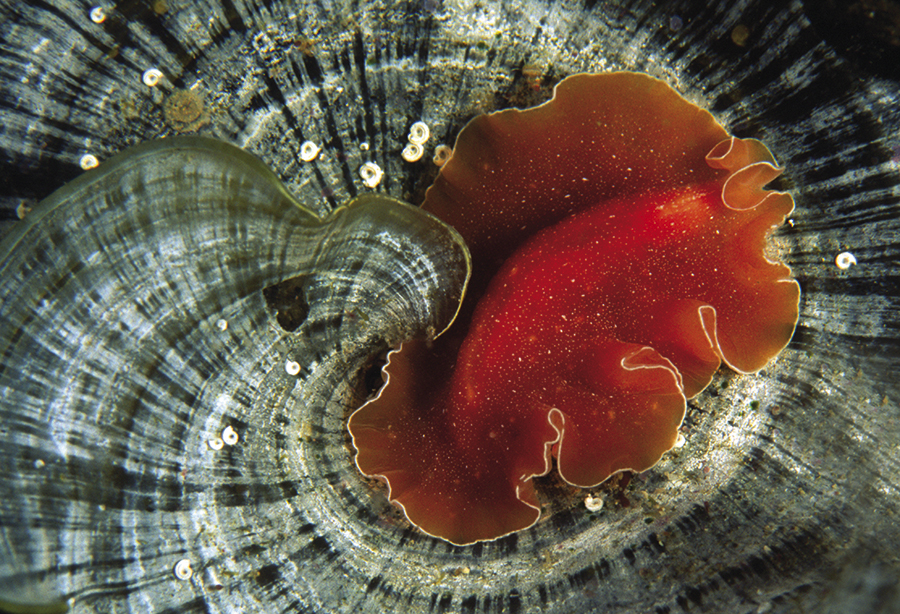
The algae, present in all the fresh and salt waters of the globe, are characterized by a huge diversity. They are simple, but not really too much, and are traditionally divided according to color. The green ones live in the very first meters of depth, thanks to the chlorophyll they possess and to the light that allows photosynthesis.
Beyond the scientific aspects, the fact remains that they frequently and massively cover up the substrate. In the middle of the colonies of algae live a lot of creatures.
A banal peacock tail alga (Padina pavonica) and a flat worm (Yungia aurantiaca) are a combination that should not appear as an attractive picture. Yet they communicate a sense of complete harmony. Flatworms, commonly known as platelmints, are widely spread in tropical waters. They are often mistaked with the nudibranchs, but, apart the spectacular liveries and the movement, they do not share much, they even belong to a different phylum, the firsts are polychaetes, the seconds are mollusks.
(Medas Islands - Spain)
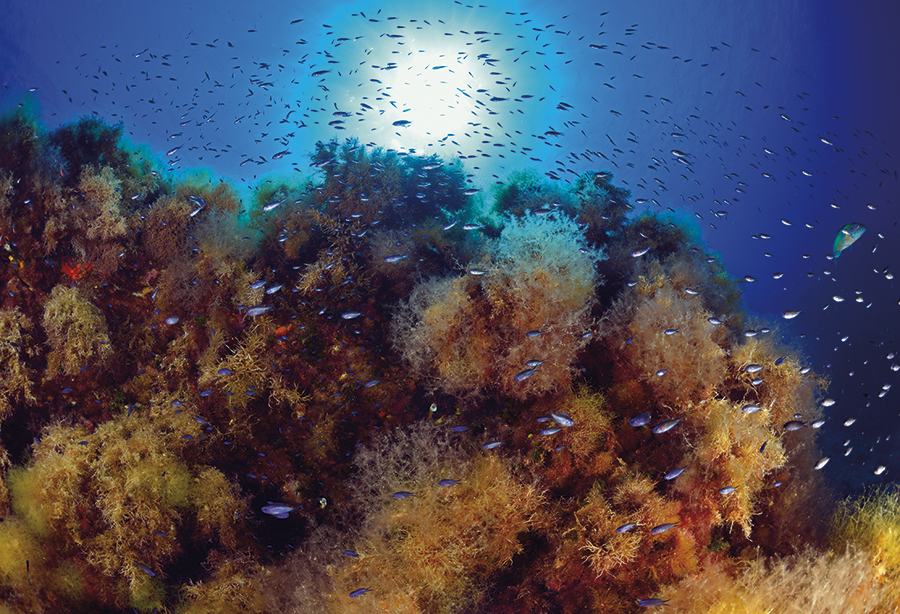
The darting of small brown damsels (Chromis chromis) and algae (Cystoseira sp.) struggling for the living space recalls the idea of a tropical reef both visually and structurally.
The brown damsels called “castagnole”, are everywhere in the first meters of depth, and they suffer a deep chromatic metamorphosis: when they are in juvenile stage they show off electric blue light, turning blue by growing and into brown to accomplished ripeness. Schools of little ones populate the first meters, in the height of summer, and are within reach of every apnea diver equipped just with a mask. He will be able to admire the frenetic blue splinters sheltered from rocky ridges. The color variation is a common event. It might give surprise, however, that the same fish, as young, besides being sometimes completely different from the adult phase. In some cases they are even more spectacular than the mature age.
(Ustica - Palermo)
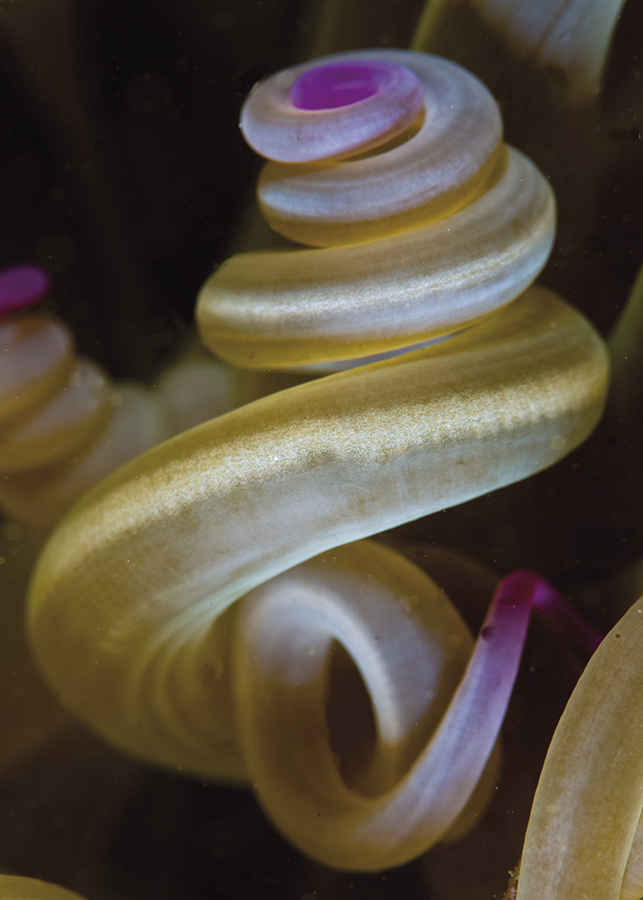
Among the rocks of the first meters of depth is easy finding green anemones (Anemonia viridis) with very long tentacles. Sometimes it happens that one of them forms particularly graphic spirals. It is a great opportunity to photographer, often frustrated by all the other arms of the coelenterate, which inevitably get in the way in front of the lens, thus producing blurred and unserviceable shots.
(Praiano - Salerno)
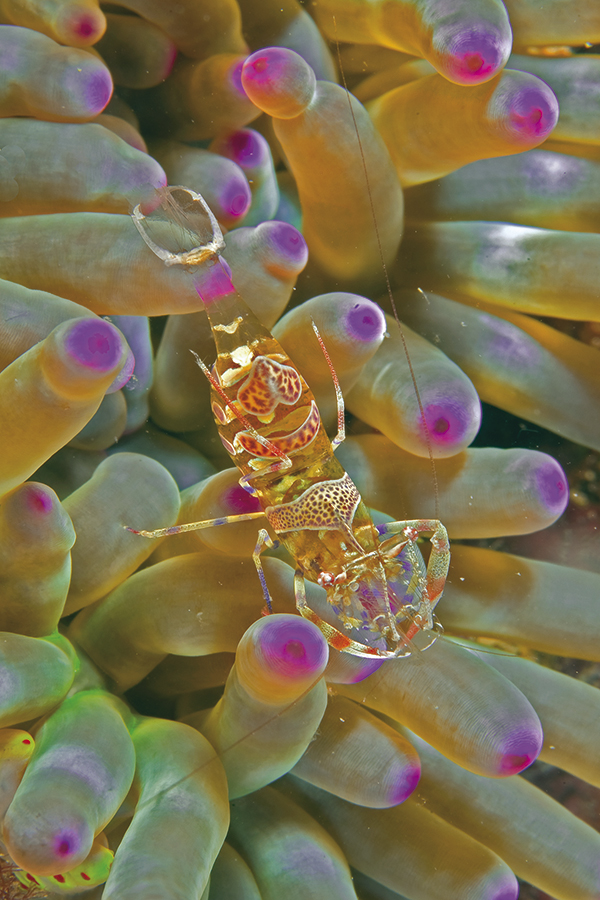
The heart shrimp (Periclimenes amethysteus), so named for the shape on the central part of the body, is a subject with an impressive design”.
The genus periclimenes is widespread throughout the world, and the beauty of some species living in the Mediterranean has nothing to envy to the highly sought after tropical, generally much easier and available towards the photographer. There are frequent cases of symbiosis, or similar on the part of Inachus phalangium spidercrabs, or the already known wonderful shrimps belonging to the genus Periclimenes, difficult to identify because of the camouflage due to the semi-transparent body, and skill to hide deep within the tentacles, or on the almost invisible outer foot of sea anemone.
A well known example of life in common with the anemone is represented by the clownfish, while a few know the constant presence of crustaceans among its tentacles.
(Giglio island - Grosseto)
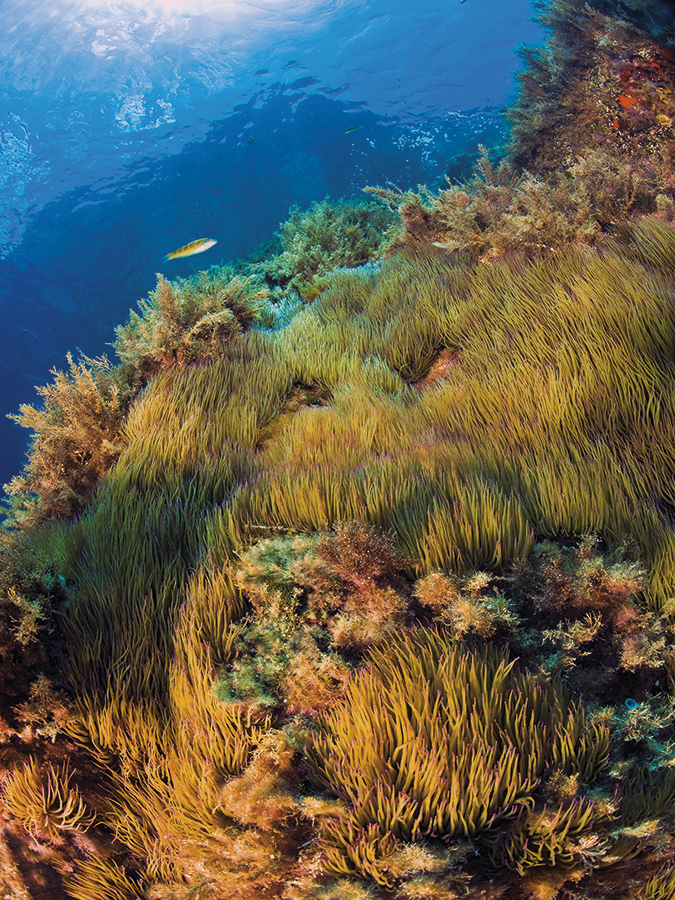
Anemones (Anemonia sp.), or actinias, on rare occasions gather in a large number of specimens. In the shot the movement of tentacles gives to the observer the feeling to be inside this “seagrass”.
(Stromboli - Messina)
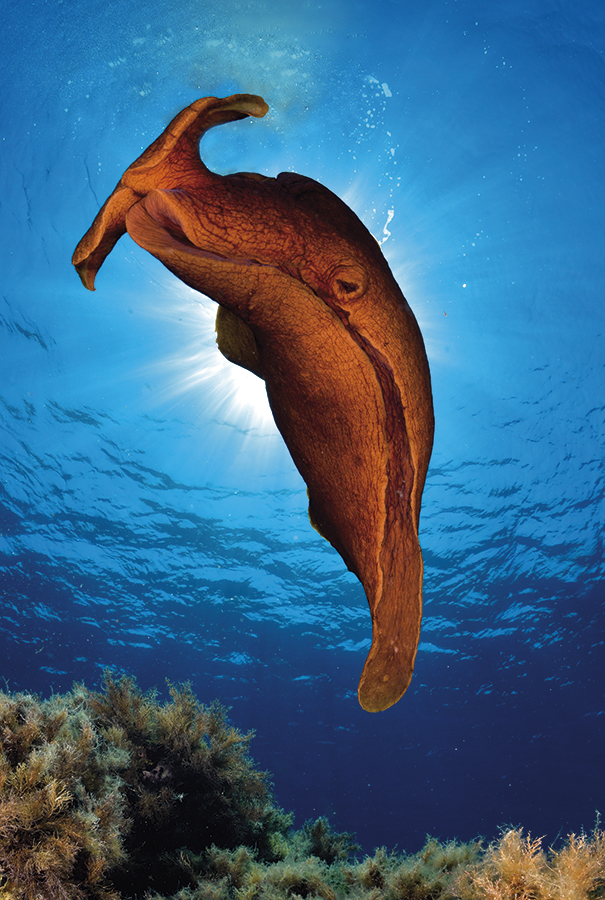
The “sea hare” (Aplysia depilans) is a typical inhabitant of environments rich with algae. It is used to fly of rock in the rocks, instead of taking on long crossings. This is a common habit to some mollusks, the most famous is certainly the so-called panish dancer, inhabitant of the tropical seas, and of the Red Sea in particular.
(Ustica - Palermo)
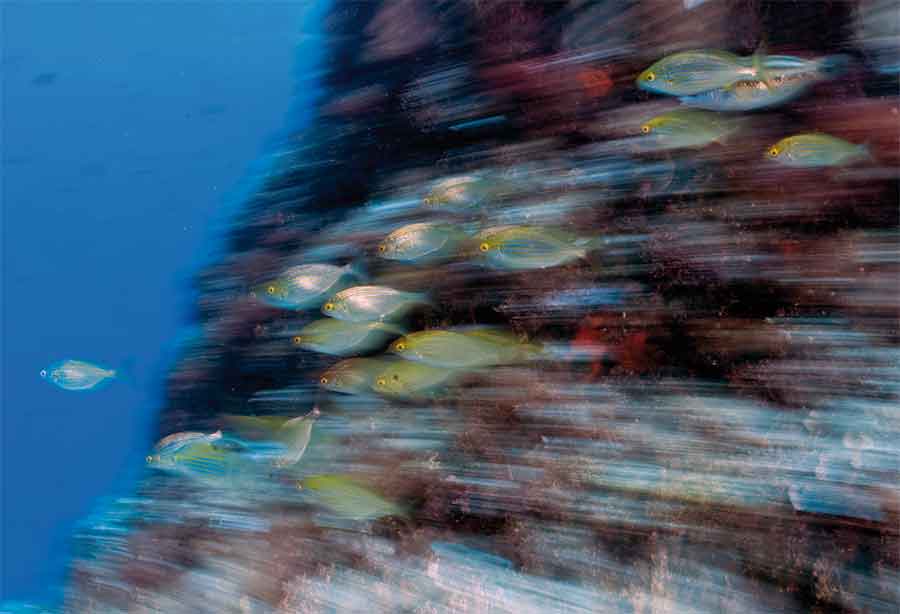
The “Goldlines” (Sarpa salpa) are joy and pain of photographers: their golden stripes and the gregarious habit makes them a very desirable subject, but when they are near enough to be able to shoot they precipitately flee and give you tails. Sometimes you get to be on time to take their side, up for a good shot. In this case the slow shutter speed enhances the sense of movement. Nobody would think at the strange psychedelic power of this fish. We will learn more about it during the final stage of our dive.
(Vervece rock - Sorrento)
FROM - 36 TO - 65 FEET (second session)
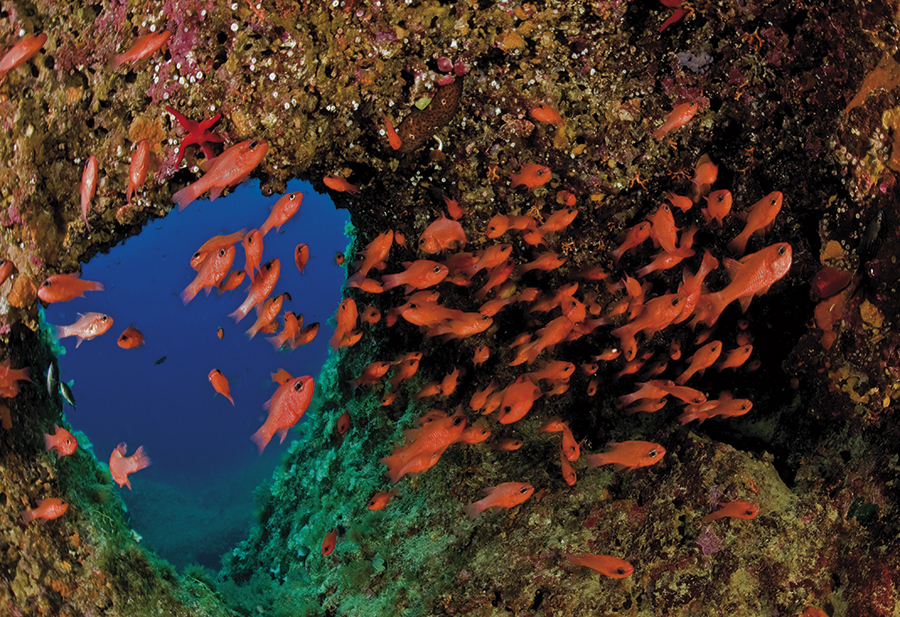
The “mediterranean cardinal fish” (Apogon imberbis) is common in the Mediterranean, you can meet in large schools and in shady areas. It is very scenic due to its bright livery and the typical white stripes enclosing the eyes.
(Punta Campanella - Naples)
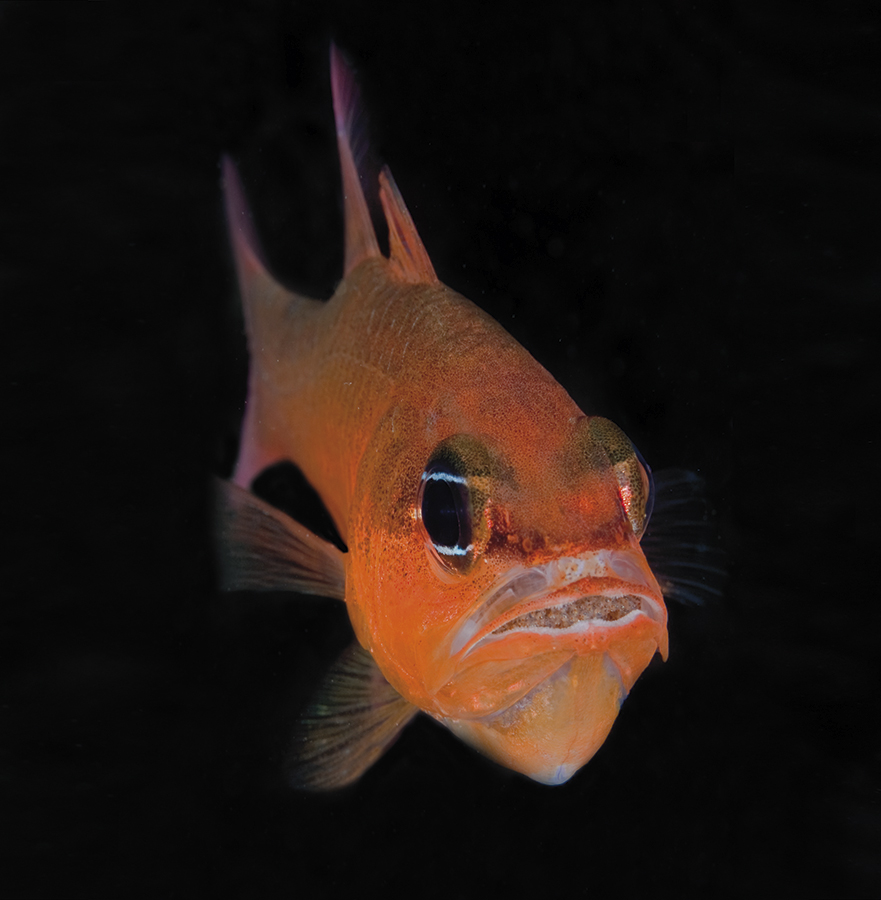
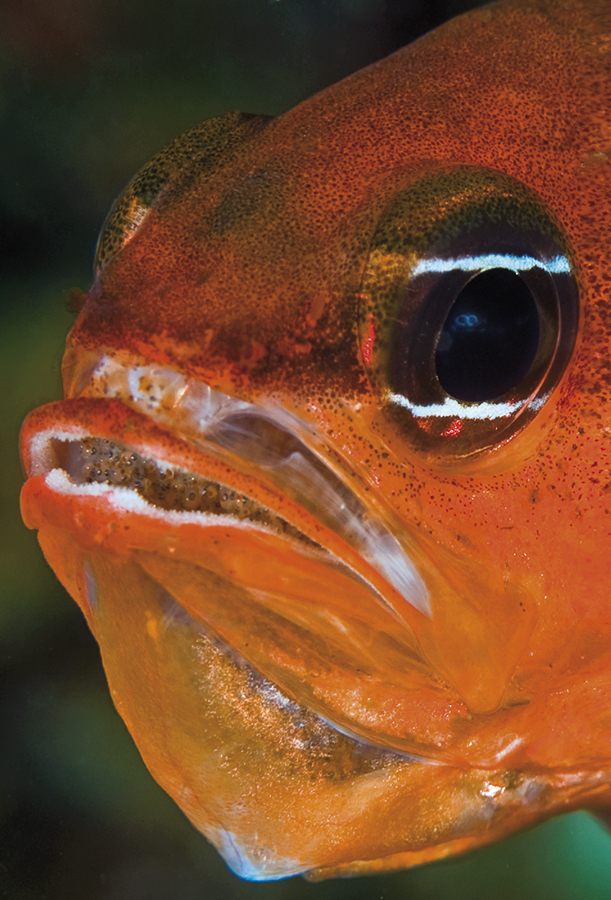
The Apogon is very reminiscent of the counterparts tropical cardinal fishes and of some tropical seas gobies because of the habit of keeping and hatching the eggs of the unborn in the mouth: the female, in fact, lays eggs inside of the male’s mouth that keeps them until hatching. Unlike the tropical counterparts which are sedentary, it swims over and over and always shows itself by tail, especially when it is in hatching phase, when it usually hides in deeper parts of the ravines and caves, probably by instinct of protection.
(Vervece rock - Sorrento)
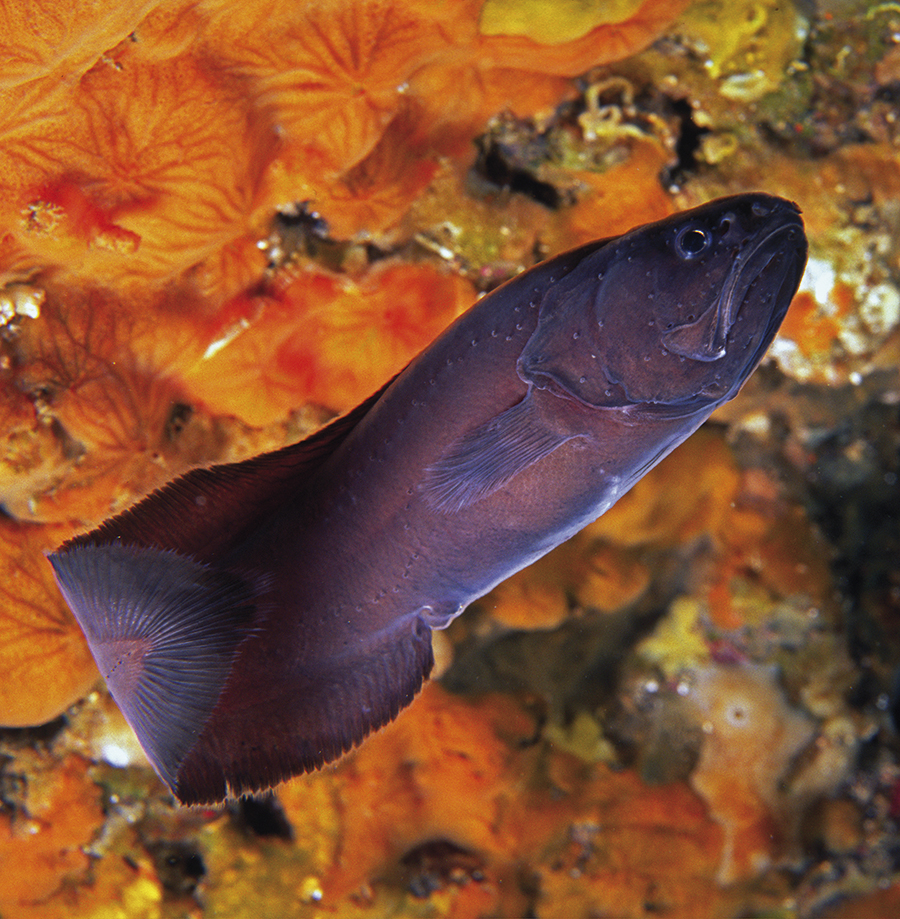
Talking about caves, the Mediterranean ones, as well as in tropical seas are rich in life and biology. In this regard, I think that meeting an abyssal fish nigh time in a cave, is like meeting darkness three times. I was in Ischia island, and the dive site was called “the rock of the ship”. I knew there was a small cave, inhabited by shrimps, but I had forgotten that night time shrimps come out of the burrows. Never a distraction was more profitable.
At the entrance to the cave, where sponges still grow, here is a rare and completely unexpected encounter: the black brotula (Grammonus ater). It is an abyssal fish that can be rarely found in caves, even at shallow depths, but just in the darkest parts, where light does not come. It’s a photo-phobic fish or, at least, such considered. It seems that these shots are the only existing documents where fish has in the background not bare rock or absolute black, but a stain of color represented from orange and yellow sponges, which need light.
This proves that the darkness, and not other factors such as the time of day or the pressure of the very high depths are sought by the species.
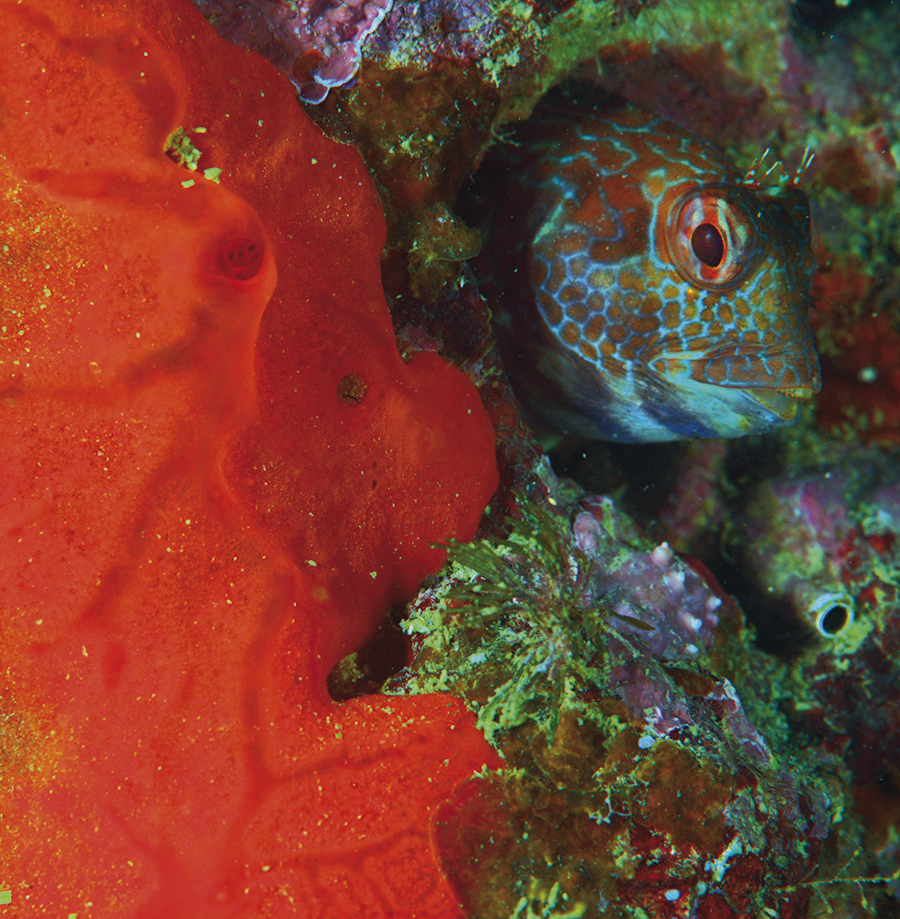
Sponges represent the crossing point between the plant and the animal kingdom.
If their almost absolute immobility, except for the reproductive phase, and the elementary structure are typical of algae, the fact that they feed on plankton takes them closer to many heterotrophic animals. Maybe the comparison to the most fitting terrestrial species is with mushrooms. Not surprisingly, in the Latin language the term “fungus” derives from the
Greek “sfongos” or “spongos”, which means “sponge”. It has recently been discovered that, in spite of the simplicity of their nervous system, sponges have sensitivity, and feel external stimulations.
Tropical fish in the Mediterranean?
It is incredible how sponges seem to have fun, beyond the absolute simplicity of the biological structure, to assume features that, with a bit of imagination, the photographer can make monsters appear, apotropaic masks or fearsome witches of fairy tales.
At the entrance of a cave the classic encrusting Spirastrella cunctatrix in profile seems a tropical frog fish threatening a helpless and unconscious blenny.
(Toro island - Corsica)
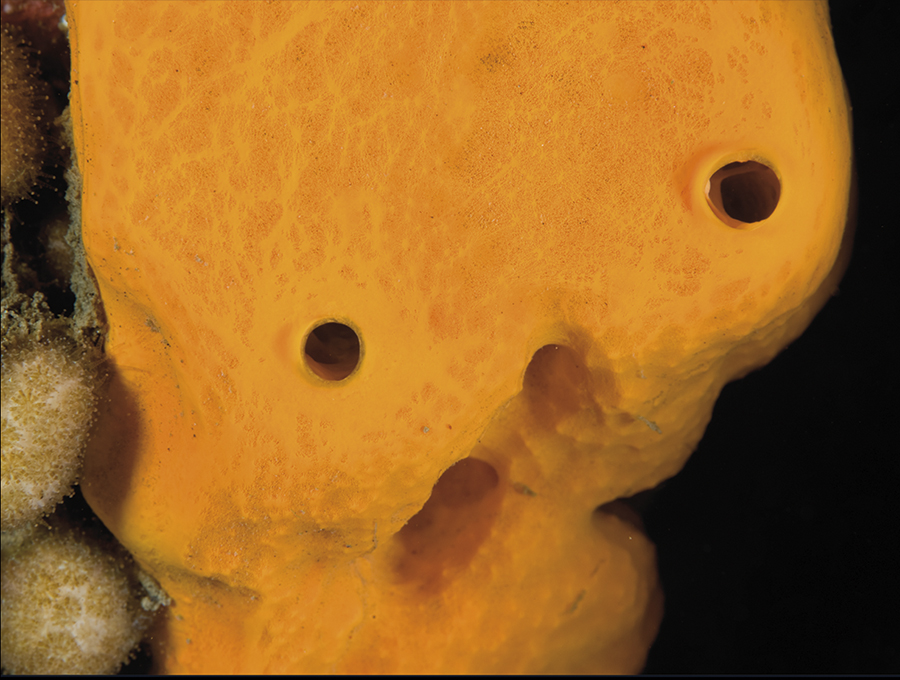
The yellow sponge (Haliclona fulva) seems to have disguised as Munch’s scream.
(Praiano - Salerno)
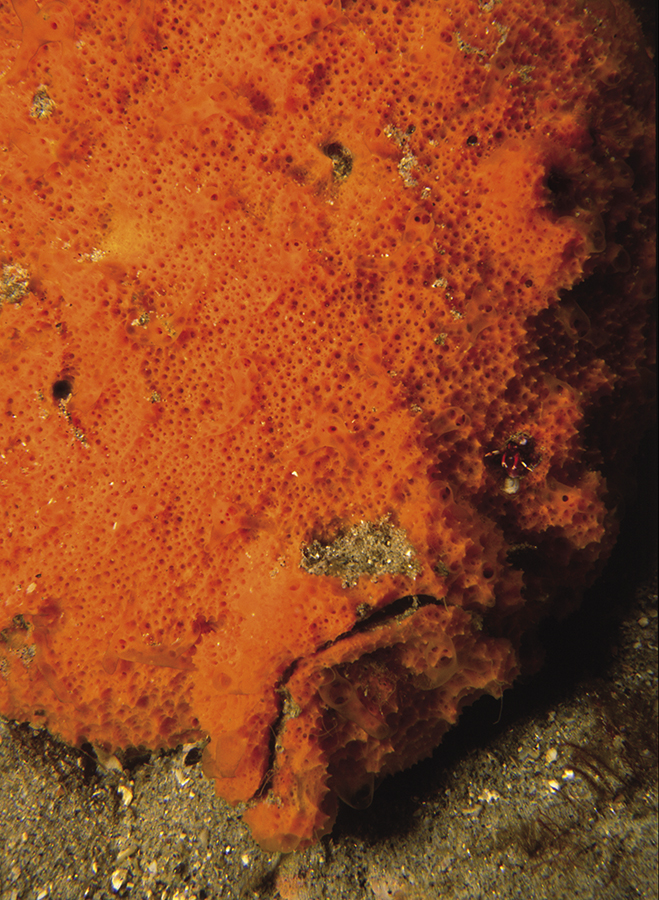
A Phorbas fictitius sponge, taken with side light, takes the form of a dreadful stone fish.
(Scilla - Reggio Calabria)
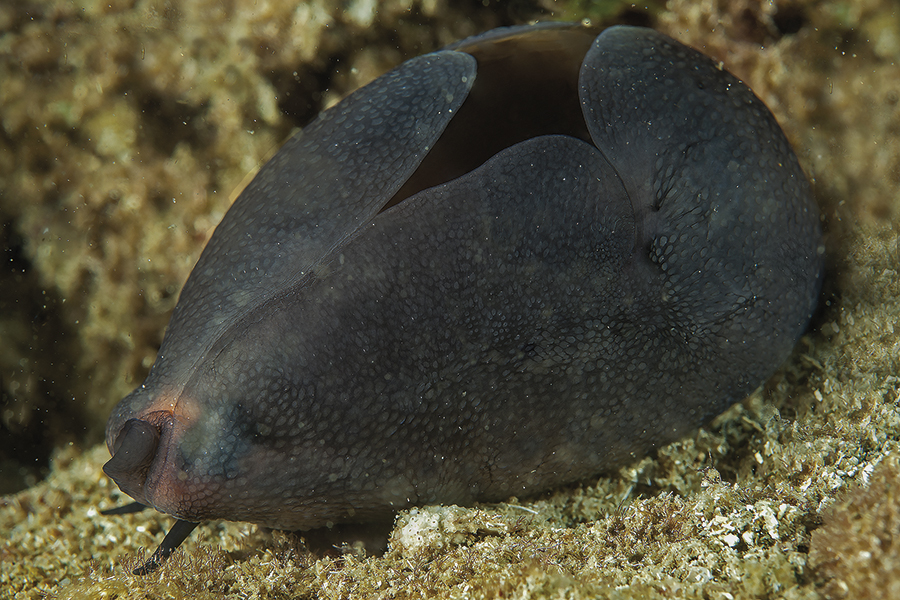
The brown cowrie (Luria lurida) lives in caves or under the stones, and it feeds on sponges. It is in danger of extinction because of collectors requests. Indeed its shell is very brilliant and never loses its color, so that easily can be found as an adornment in bracelets and necklaces. This is a lucky shot because the mollusk immediately hides its grey mantle when it is lighted and disturbed, while here it is almost completely covered. It was inside a little hole and I was able to focus spotting just a little part of the mantle, so that its sensors didn’t feel the
presence of the photographer.
(Capri - Naples)
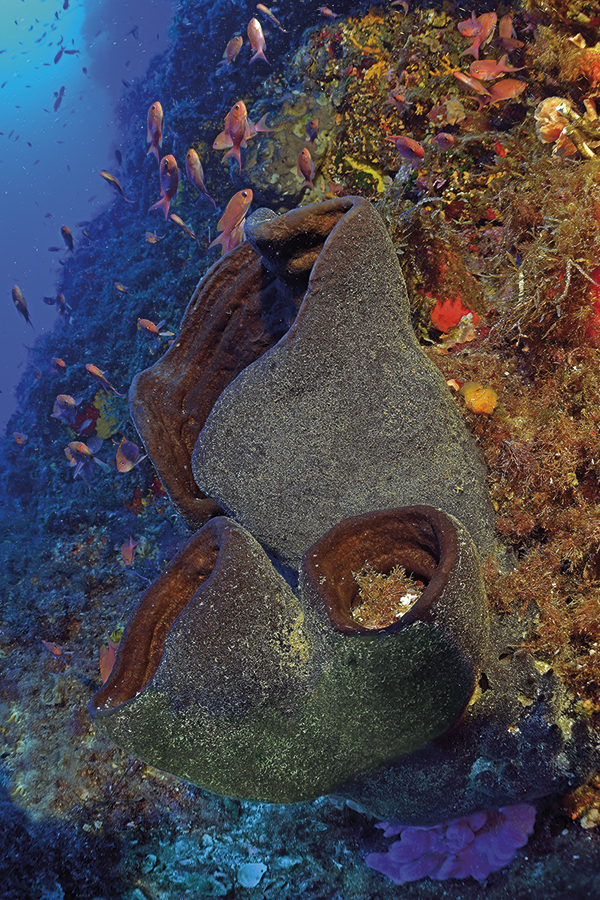
The striking resemblance of Mediterranean rare, goblet sponge (Calyx nicaeensis) to ones living along the walls of the Caribbean Sea and Pacific reefs is fascinating. Goblet sponges, particularly in the Caribbean, are sometimes used as a temporary den by various fishes which find protection in. These scenes allow captivating shots, unless photographers run into disturbing presences inside the sponge. It was recently found out the spread of several specimens of scorpion fish, which is instead a typical inhabitant of the Red Sea and the Indo-Pacific Ocean. It is not known how it came to Atlantic, it is thought of some specimens superficially freed from domestic aquariums or trapped in the hold of some ship, but the presence is causing a real environmental disaster, since scorpion fishes are very voracious and have no natural enemies in that sea if not ... divers armed with speargun and, perhaps sharks.
(Ustica - Palermo)
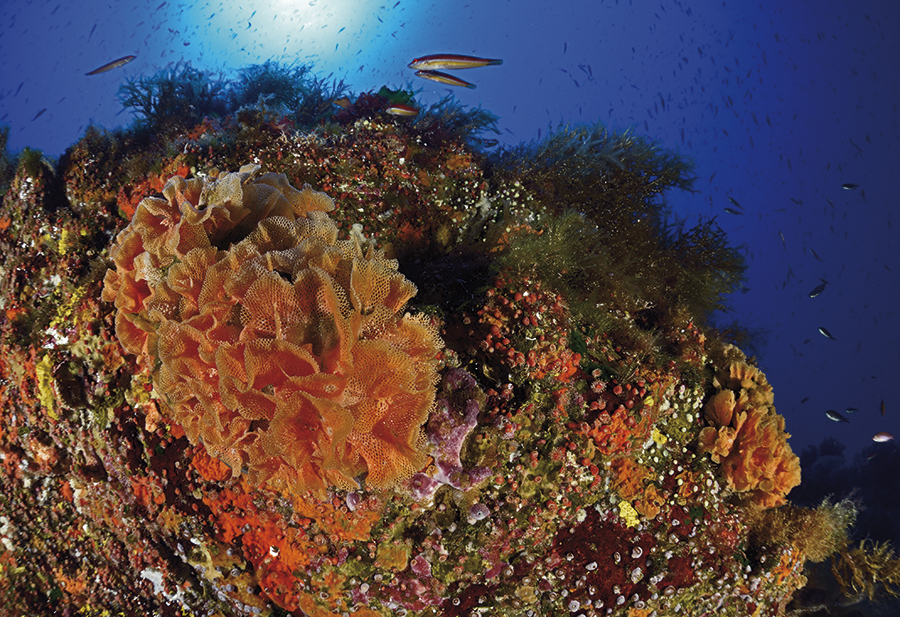
The Reteporella grimaldii are real laces of the Mediterranean sea, as they are known. They have a very delicate structure, and they love shady areas.
Pastel pink, they vaguely recall some corals in shape, color and friability. They belong to the bryozoans, colonial animals reporting the typical characteristic of some vertebrates of being hermaphrodite, or of changing sex according to the needs of the community, to ensure survival.
(Ustica - Palermo)
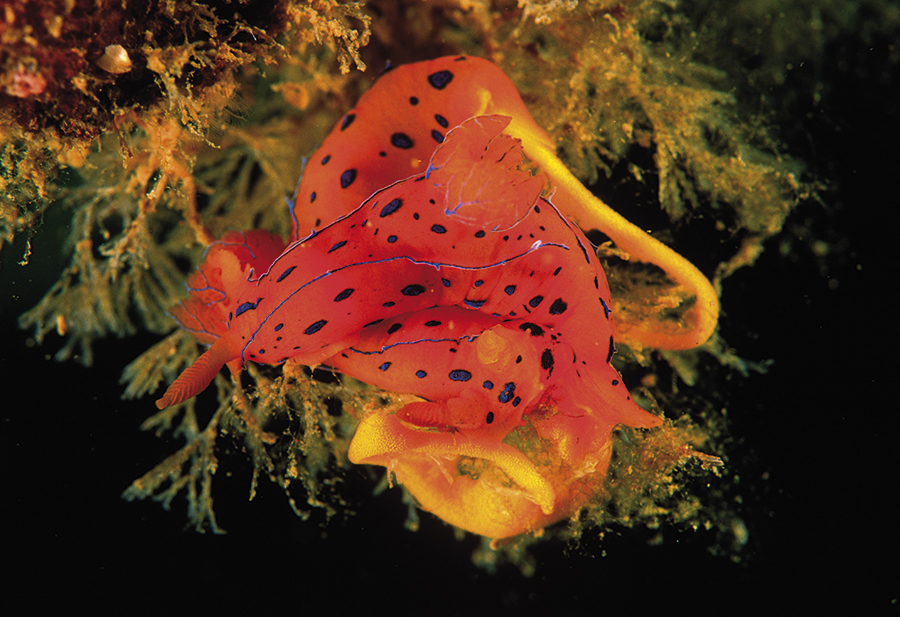
The Reteporella grimaldii are real laces of the Mediterranean sea, as they are known. They have a very delicate structure, and they love shady areas.
Pastel pink, they vaguely recall some corals in shape, color and friability. They belong to the bryozoans, colonial animals reporting the typical characteristic of some vertebrates of being hermaphrodite, or of changing sex according to the needs of the community, to ensure survival.
(Ustica - Palermo)
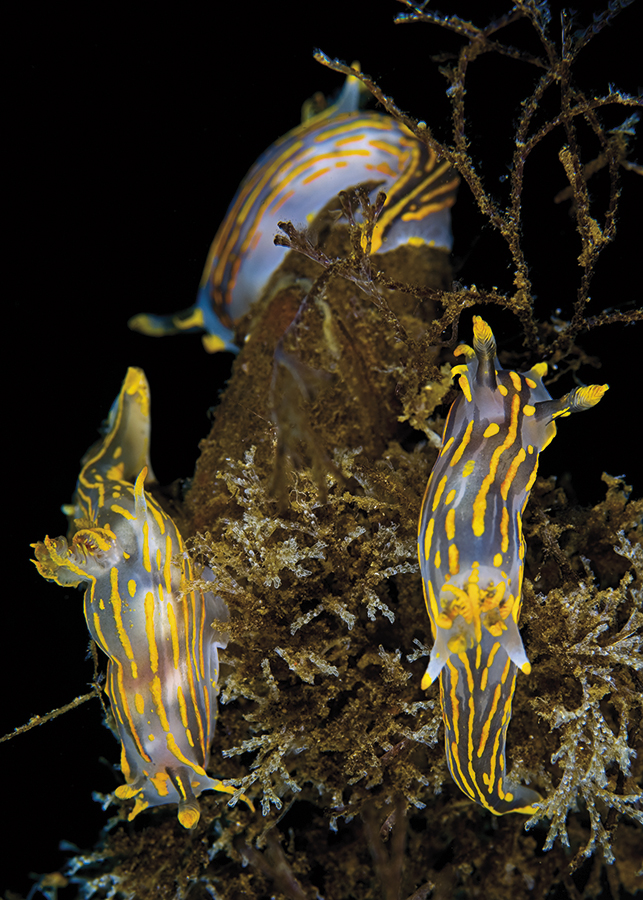
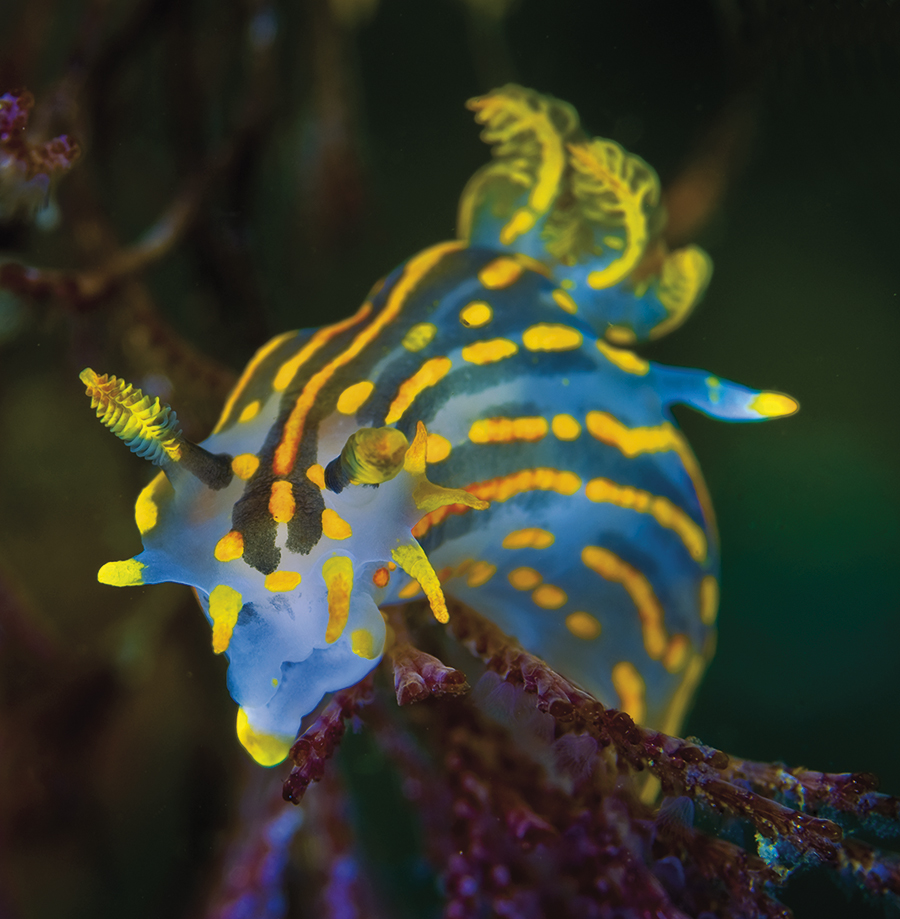
The striped policera (Polycera quadrilineata) is spread in the Atlantic ocean too. It spends life on bryozoans of the genus bugula. It sometimes happens to meet more specimens feeding on bryozoan. When they set as in picture, they make the photographer’s joy.
(Baia town – Naples)
Many species of these mollusks, not by chance the more colorful ones, are poisonous, in spite of the little size that they would make them appetizing morsels for larger animals.
The conspicuous coloring, therefore, scientifically called “aposematic”, does not represent a showing off of an animal looking for partners, but a warning: “I am indigestible, don’t try to eat me “.
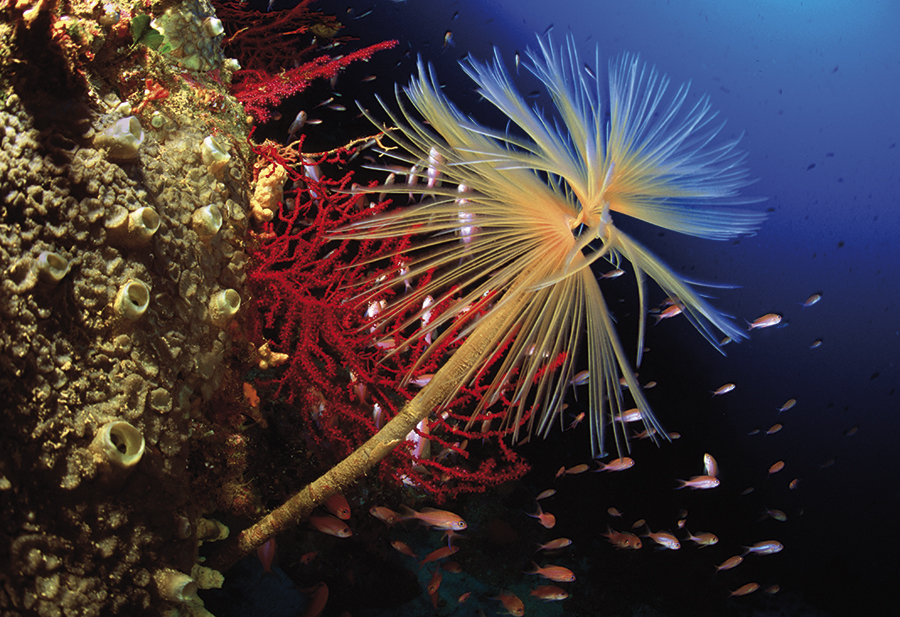
Spirografo feather duster worms (Sabella spallanzanii) are held by many biologists as the most elegant worms of the animal world. They are typical inhabitants of the Mediterranean. Specimens like the one in the shot make coral walls richer.
The feathered appendages are very sensitive and work as breathing organs and... tape conveyor. Feeding on plankton, the system of ingesting food is somewhat ingenious, because in nature hardly “beauty”, according to human canons, end to itself. The captured food, in fact, is carried by the peduncles of the arms such as a conveyor belt in the tube where it is digested. The tube is made with its mucus, muck and sand, and despite being by far the least ostentatious part of the animal, it plays essential functions.
In fact, it is fixed on the substrate, ensuring worm’s stability and, above all, withdraws from it when it is disturbed. In fact, it often happens that the animal, frightened by the approach of strangers, suddenly disappears inside. Really it does not appear that he has natural enemies as, moreover, its relatively large size compared to similar ones.It is thought that withdrawing is caused not both from the approach of other subjects, but from sudden variations in intensity bright, as Sabella spallanzanii has photo sensors at the base of the feathered arms. This is the only way to explain frequent, almost parasitic use of the tube by many species such as seahorses, hermit crabs and tunicates, which obviously exploit the grip to obtain the plankton particles escaped to ingestion.
(Capri - Naples)
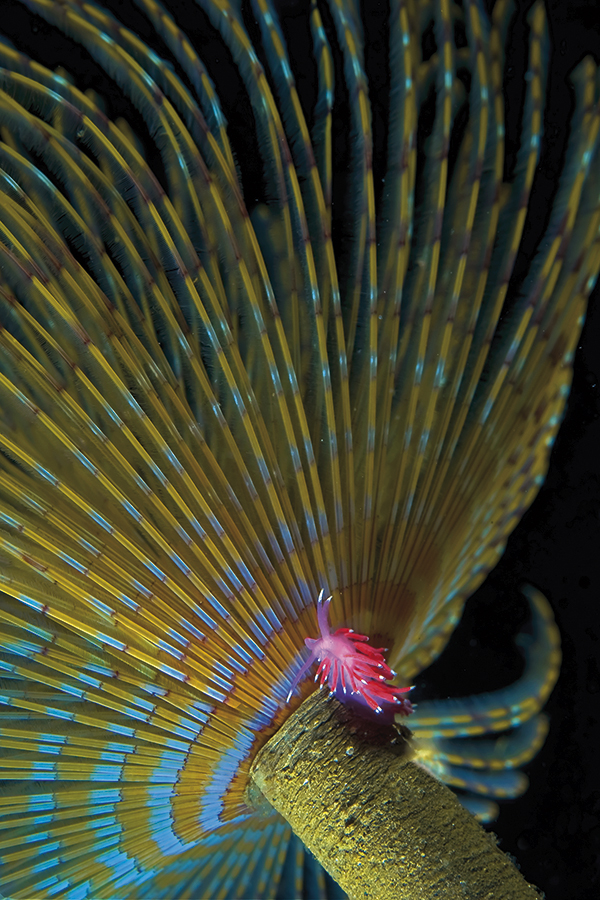
Only a few years ago was documented - at the beginning it was speculated they were photographic tricks - how even the nudibranchs sometimes venture along the calcareous tubes and even along the plumage of Sabella spallanzanii feather duster warms, although they surely don’t feed of. It is probably a trivial searching of food, which offers chances for outstanding graphic and chromatic shots.
(Pozzuoli - Naples)
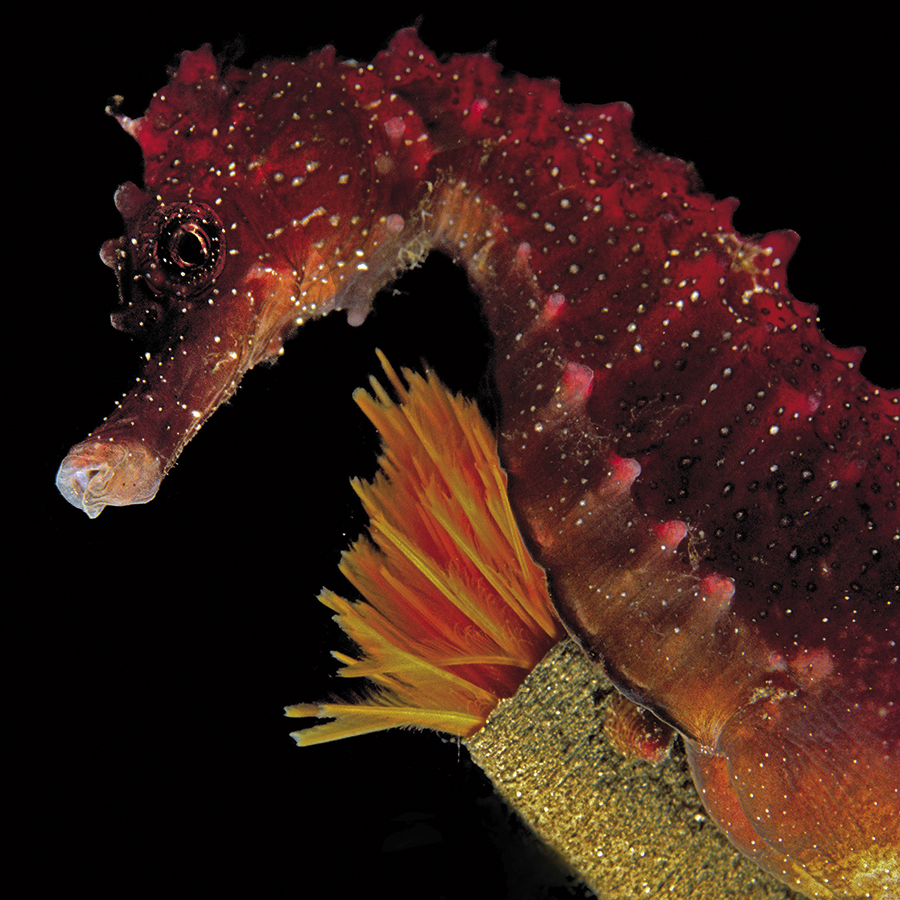
The tubes of sea dust worms are often the support for very interesting animals like the branchy horse (Hippocampus guttulatus), that because of movements and coloring recalls many seahorses living in Tropical and sub-tropical environments.
Seahorses are becoming increasingly rare in the Mediterranean, but they are disappearing in the Pacific area too. Despite the fact that it is an absolutely not edible fish because of its small size and the bone flakes that form its body, it is considered a powerful aphrodisiac, really victim of a foolish and indiscriminate fishing. It is literally grated on many oriental dishes.
Yet, it is a creature of great charm: its head is similar to that of a horse; despite being a fish it does not love swimming, but it is always "anchored" to some support using its
prehensile tail as some kinds of monkeys and others animals; finally, it swims vertically.
Perhaps the most interesting circumstance is that the female lays the eggs in the male's pouch, which hatches them up at birth. A situation that is very similar, in some ways, to the one of the mediterranean cardinal fish met in the cave ... a few meters above.
(Scilla – Reggio Calabria)


